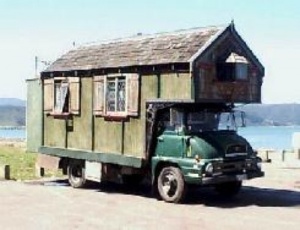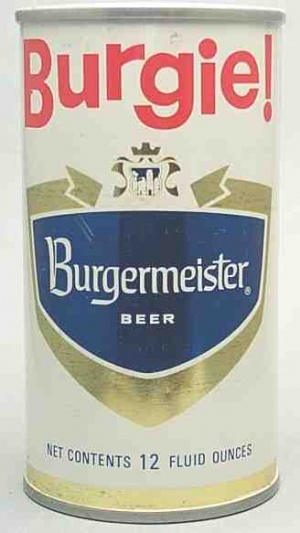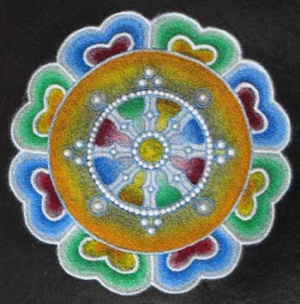Chapter 4
- Please keep these annotations SPOILER-FREE by not revealing information from later pages in the novel.
Page numbers refer to editions with 385 pages, where the story begins on page 3. Not sure if there are other editions with variant pagination. Please let us know otherwise.
Contents
Page 35
"camper shell whose unusual design gave the vehicle some cornering problems"
It's called a "housetruck". The one to the right is larger than Trent's.
"imbrication"
An overlapping, like leaves, fish scales, or certain geological strata.
"depraved yuppie food preferences"
Go get 'em, TP!
Ecrivisses a la Maison
Crawfish at Home
"RC and Moonpie"
Names taken from Big Bill Liston's 1951 hillbilly hit, "Gimme an RC Cola and a Moonpie." The MoonPie was the original marshmallow sandwhich. Back then you could buy an RC Cola and MoonPie for 10 cents, and some consider the favorite fast-food lunch of the 1950s, at least in the South. More on that MoonPie...
According to numerous internet sources, Royal Crown Cola had its origins in a company founded by Claude Hatcher in 1905 in Columbus, Georgia. The company's original cola offering was Chero-Cola, reformulated and renamed Royal Crown in 1933.
Page 37
"Beer riders"
A nice conceit, typically Pynchonian: kamikaze rednecks racing through the tule fog.
"behind a 409"
This would be a 60s Chevy with a 409 cu. in. engine, made famous by the Beach Boy's hit "(She's real fine my) 409". The 1960s saw an arms race regarding engine size, with the Chevrolet 409 topping the Ford 406 cu. in. in 1961, and Chrysler topping Chevrolet with the 426 Ramcharger. More on the Chevy 409...
"tule fogs"
Tule fog, named after California tule grass, is a thick fog endemic to California's Central Valley. It has led to many spectacular chain-reaction automobile collisions, some involving dozens of cars.
"white presences, full of blindness and sudden highway death..."
Echoes the "white visitation" of Gravity's Rainbow, as well as Melville's whiteness of the whale. Also a pungent evocation of graveworms: There's more death in this phrase than meets the eye, foreshadowing the Thanatoids.
"...all at once, there in the road, a critter in a movie..."
A Japanese horror movie, no doubt! (See note, p. 65.)
Dick Dale
Dale, a left-handed Californian (two strikes against) guitar player, was dubbed "King of the Surf Guitar" in the 1950s – and there's some truth to his claim that he invented surf music. He made a surprise reappearance in a commercial for the Nissan Armada in 2004 and 2005. Dick's website
Page 38
who ended up doing the Stroll
The Stroll was both a slow rock 'n' roll dance and a song that was popular in late 1950s. The dance called the Stroll began in black communities to the songs "C. C. Rider" and "Betty and Dupree" by Chuck Willis. Willis was known as "The King of the Stroll" prior to the release of the song of that name. WIKI
In the 1950's the Stroll was typically done as a slow line dance, but here is a more animated version from 1957 with only four dancers (as Pynchon suggests).
"Pipeline"
"Pipeline" is a surf rock tune by The Chantays which was recorded in 1962. The tune, originally called "Liberty's Whip," was renamed after the band members saw a surfing movie showing scenes of the Banzai Pipeline in Hawaii. The tune, fitting in with the popular surfing craze of the time, swiftly rose up the Billboard Pop charts, reaching #4, and becoming a classic hit of its time. The tune is notable for using Alberti bass chords. WIKI Listen on YouTube
a can of Burgie
Burgermeister Brewing Company was a brewery out of San Francisco during the 50's & 60's. One of their beers was called Burgie. For history see here and here. To watch a Burgie TV commercial from this era on YouTube, click here.
Page 39
"her already notorious blue eyes"
Frenesi's blue eyes are certainly notorious to analysts of Pynchon's imagery. Cf. Blue in Vineland and Color Codes.
When it isn't obscured by smog or fog, the sky in California appears intensely blue due to low humidity. This is particularly striking to someone born on the East Coast (like Pynchon). Frenesi, a California Girl, has this sky internalized, visible in her eyes. In addition, blue eyes are "Nordic" characteristics, with all the symbolic baggage this carries in Pynchon's work.
"Frank Zappa's face...Mount Rushmore"
From an interview quoted on the Zappa Wiki, Frank contemplated the need for an additional Rushmore-like mountain carved with the faces of Richard Nixon, J. Edgar Hoover and Ronald Reagan. The interview is dated as 1990, so it's possible Pynchon hadn't come across the quote at the time of Vineland's publication.
Perhaps Zoyd is simply seeing a similarity between Teddy Roosevelt's mustache and Zappa's.
"...do you think that love can save anybody?"
"Save" is Calvinist/Christian terminology -- another reference to the binary distinction between elect and preterite, one and zero.
Page 40
"I was awake. But out of my body."
Typical hippie stuff here, Zoyd practicing Astral Projection. WIKI
"Mr. Sulu"
The navigator on Star Trek
Page 41
"The Steam Donkey"
A bar named after the logger's mechanical badass winch.
Lucky Lager
Lucky Lager was first commercially introduced in 1934 by the General Brewing Company. The General Brewing Company was founded in San Francisco, California by Eugene Selvage (who would remain owner and CEO until 1961). The following decade saw Lucky Lager grow to be the sales leader in the entire West. After the Vancouver brewery shut down in July 1985, the Olympia Brewing Company in Tumwater, WA began to produce this lager. WIKI
"...she rilly freaked when she found out she was pregnant"
As we'll see in the final chapter, Vond's last escapade is mostly an attempt to abduct Prairie. So the paranoid reader might ask: Is Frenesi merely a convenient mechanism to set up all of the important stuff in the book? Or is she simply Patty Hearst in reverse?
She's the MacGuffin.
Page 42
"...time to go to commercials..."
Zoyd remembers expecting life to be like TV -- a dangerous side-effect of TV addiction. The passage goes on to note that Zoyd was "Sent...gaga by those mythical days of high drama..."
"Le Bucheron Affame"
Probably The Starving Logger, but possibly The Starving French Goat Cheese.
Page 43
"Humbolaya Restaurant"
Humboldt County + Jambalaya (with tofu etouffe, yet!).
Also, Humbo sounds a lot like Gumbo; Zoyd's deliveries to those "California Cajun" restaurants mentioned earlier in the chapter.
"After a short recorded program of themes from famous TV shows..."
The telephone "hold" circuit at NEVER plays TV themes, which is like calling Alcoholics Anonymous and getting a medley of "One Scotch, One Bourbon, One Beer" and "Hey Bartender." But of course, the "VE does stand for "Video Education"...
"Little Charlie and the Nightcats singing 'TV Crazy'"
Real band, real song.
Hear it on YouTube.
The song was first released on their album All the Way Crazy in 1987, so this is either an anachronism or a bootleg. Pynchon probably couldn't resist. It's available on Amazon.
"'Ti Bruce"
'Ti = Creole/Cajun shorthand for petit = little, hence Ti Bruce = Little Bruce. Can chef 'Ti Bruce be a gag on Bay Area chef and sausage-maker "Big Bruce" Aidells? Seems unlikely...but you never know.
beignets and chicory coffee
Ideal New Orleans breakfast, most famously served at the Cafe Du Monde. CAFE DU MONDE SITE
"Rick & Chick's Born Again"
Autobody shop with a similar ideal as "Resurrection of the Body" in Inherent Vice.
"didt'n"
According to Google Books, this spelling occurs 12 times in Vineland, and twice in Against the Day. It also occurs at least once in Inherent Vice.
Page 44
El Mil Amores
A Thousand Loves
"script possibilities"
Presumably, an off-the-cuff creation of a believable cover story concerning some vehicle's provenance.
the Mattole
The Mattole River is a river on the north coast of California, that flows northerly, then westerly into the Pacific Ocean. Communities, from north to south, closely associated with the Mattole River include: Petrolia, Honeydew, Ettersburg, Thorn Junction, and Whitethorn. The river enters the ocean at the Mattole Estuary about 4 miles west-southwest of Petrolia and 10 miles south of Cape Mendocino. WIKI
Page 45
"another one of those intestinal pangs"
... of fear. See also pages 10, 116, 207, 299.
"the slowest fast food in the region"
Hilarious riff on trendy California health-food pizza.
Page 46
"The Marquis de Sod."
Hazardously funny.
Page 47
"those old split 30's during the vampire shift"
TV ad lingo, referring to 15-second TV spots (splitting a 30-second commercial break) often on in the wee hours. Vampire shift is a Pynchon usage, we think; more common is "graveyard shift."
"A lawn savant..."
An amazing goof on "La Marseillaise" ("allons enfants...")
Page 48
"more liens than the tower of Pisa...more garnishes than a California burger"
Bad, bad puns. Bad, bad Pynchon.
Brecht
Bertolt Brecht (1898–1956) was a German poet, playwright, and theatre director. An influential theatre practitioner of the 20th century, Brecht made equally significant contributions to dramaturgy and theatrical production, the latter particularly through the seismic impact of the tours undertaken by the Berliner Ensemble – the post-war theatre company operated by Brecht and his wife, long-time collaborator and actress Helene Weigel. WIKI
"Pat Sajak in The Frank Gorshin Story"
Gorshin was a hollow-eyed comedian and TV celeb from the late fifties, sort of a cross between Dan Duryea and Richard Widmark. He was probably best known as The Riddler on the Batman TV show.
Pat Sajak is the friendly, self-deprecating host of the TV show Wheel of Fortune, mentioned on page 12.
Page 49
Bodhi Dharma Pizza
Ginsberg, Kerouac, and many of the other beat writers were deep into Zen Buddhism, including the famous zen koan that asks Why Has Bodhi-Dharma Left for the East? Some of that trickled down to the hippies, their (sort of) spiritual descendents.
Page 50
"Brock Vond"
Another badass "V." Pynchon has a long-standing history of bad guys whose names start with "V." In this case, as we will see, the V stands for Vampire as well as Villain.
Rock von BD?.
civil RICO
The Racketeer Influenced and Corrupt Organizations Act, commonly referred to as the RICO Act or simply RICO, is a United States federal law that provides for extended criminal penalties and a civil cause of action for acts performed as part of an ongoing criminal organization. The RICO Act focuses specifically on racketeering, and it allows for the leaders of a syndicate to be tried for the crimes which they ordered others to do or assisted them, closing a perceived loophole that allowed someone who told a man to, for example, murder, to be exempt from the trial because he did not actually do it. WIKI
Page 51
"eightfold pizzic mandala"Extending the Buddhist riff on "Bodhi Dharma Pizza" on p. 49: Eightfold because pizza is always cut into 8 slices, which reminds Pynchon of the eightfold path of classic Buddhism. Also, pizza is round, like those beautiful symbols of that eightfold path.
"all those long-ago political wars"
Presumably referring to the decades of class struggle that form the subtextual background for this novel – from the (IWW) Wobblies at the turn of the 20th Century and the general labor strikes of the 1930s through the freedom rider/Black Panther/ hippie/yippie activism of the '50s, '60s and '70s, and on into the battle for existence carried on by progressive people against ever-increasing attacks by the legions of corporate evil headed by Nixon and Reagan in the ‘70’s and ‘80’s.
Page 52
"Baba Havabananda"
i.e., have a banana. Groucho Marx meets Swami Satchidananda at R. Crumb's?
Page 55
"like a time machine departing for the future..."
Fine writing.
This bit also brings to mind Rev. Wicks Cherrycoke's conveyance in Mason & Dixon.
| Chapter 1 pp. 3-13 |
Chapter 2 pp. 14-21 |
Chapter 3 pp. 22-34 |
Chapter 4 pp. 35-55 |
Chapter 5 pp. 56-67 |
| Chapter 6 pp. 68-91 |
Chapter 7 pp. 92-106 |
Chapter 8 pp. 107-129 |
Chapter 9 pp. 130-191 |
Chapter 10 pp. 192-203 |
| Chapter 11 pp. 204-217 |
Chapter 12 pp. 218-267 |
Chapter 13 pp. 268-293 |
Chapter 14 pp. 294-322 |
Chapter 15 pp. 323-385 |


